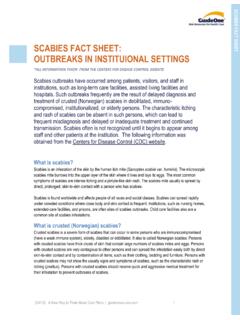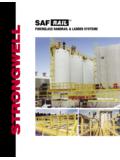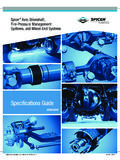Transcription of COMMERCIAL KITCHEN FIRE SAFETY
1 COMMERCIAL KITCHEN fire SAFETY . COMMERCIAL KITCHEN fire . SAFETY . COMMERCIAL grade kitchens are a common feature found in senior living communities. Operation of a COMMERCIAL grade KITCHEN , many SAFETY considerations should be addressed, including food SAFETY , employee and volunteer SAFETY , and fire SAFETY . This fact sheet addresses the specific issues associated with providing adequate fire SAFETY for your KITCHEN . COMMERCIAL KITCHENS. COMMERCIAL cooking operations are defined as kitchens that have cooking equipment that produce grease and grease laden vapors. This includes flat grills, char broilers and deep fat fryers. The typical residential range (electric or gas) would not be considered a grease producing appliance. Other equipment, such as ovens, microwaves and steam kettles also fall into the non-grease producing appliance category. The following is information regarding two of the most common types of equipment that produce grease and/or grease laden vapors.
2 Deep Fat Fryers Deep fat fryers are a major cause of KITCHEN fires. Oil can splash and easily come into contact with an open flame from an adjacent piece of cooking equipment, such as a gas-fired range top. A 16-inch clearance must be maintained between the deep fat fryer and the open flame cooking equipment. If a 16-inch clearance is not possible, a vertical steel barrier extending 12 inches above the top of the deep fat fryer or open flame appliance(s) can be used as an alternative means of protection. The normal temperature range for food service frying is 325. to 375 degrees Fahrenheit. As the oil temperature increases, so does the risk of an accidental grease fire . All deep fat This photo illustrates the correct installation of a metal baffle plate between the fryers should be equipped with a high temperature limiting open flames from the range and the deep fat fryer. Metal baffles should be device, which will shut off the fuel or energy in the event used only when there is not sufficient space available to provide a 16-inch the cooking oil exceeds a temperature of 475 degrees clearance between the deep fat fryer and any source of open flames.
3 Fahrenheit. CM 17265 (12/11) COMMERCIAL KITCHEN fire SAFETY | 1. Flat Grills/Griddles Flat grills and griddles are typically used for frying hamburgers and bacon. When used for this type of cooking, grease and grease laden vapors will be produced. To adequately control the fire hazard associated with these types of cooking operations, two fire protection components must be installed: a hood and ventilation system and an automatic extinguishing system. HOOD AND VENTILATION SYSTEM. A KITCHEN hood and ventilation system will include an exhaust hood or canopy, ductwork, fan system, and a means of providing adequate make-up air. This system will effectively remove the heat, grease and grease laden vapors from the cooking area. Installation The hood and ventilation system should be professionally installed according to National fire Protection Association Standard 96. (NFPA 96 Standard for Ventilation Control and fire Protection of COMMERCIAL Cooking Operations.)
4 Local fire officials also should be consulted, as additional requirements under county and/or municipal codes could apply. The hood must be equipped with the appropriate grease removal filters. Only baffle style filters comply with NFPA 96 and should be used in cooking operations that produce a moderate to heavy amount of grease. Mesh filters are not appropriate for COMMERCIAL cooking operations and do not comply with NFPA 96. Filters should be cleaned regularly to prevent the build-up of grease. Lighting units should be equipped with tight fitting protective globe lights with steel enclosures that are mounted on the outer surface of the hood. All electrical equipment should be installed in accordance with NFPA 70 National Electric Code by a licensed electrician. The photo to the left is an example of KITCHEN appliances that are properly equipped with an appropriate hood and ventilation system. 2 | COMMERCIAL KITCHEN fire SAFETY CM 17265 (02/12). COMMERCIAL KITCHEN fire SAFETY .
5 Maintenance Hoods, grease-removal devices, fans, ducts and other equipment should be serviced by a qualified contractor at intervals necessary to prevent the accumulation of grease. Frequency of cleaning will depend upon the amount of grease observed during an inspection. A six month interval is standard, but unusually heavy grease accumulation may require more frequent cleaning. A written cleaning schedule should be established indicating the methods of cleaning and the time intervals. Following the inspection or cleaning, a label indicating the date cleaned and the name of the servicing company should be prominently This photo shows ductwork from a cooking area that has a heavy accumulation of displayed. It is recommended that this label be grease. Maintaining and cleaning the hood and ventilation system is crucial, as the attached to the exterior of the hood in a visible buildup of grease can become a serious fire hazard. The hood and ventilation system should be inspected and cleaned by a certified contractor every six months.
6 Location. AUTOMATIC EXTINGUISHING SYSTEM. All cooking equipment that produces grease or grease- laden vapors should be equipped with an approved automatic extinguishing system. The automatic extinguishing system should meet the Underwriters Laboratory (UL) 300 standard. UL 300 went into effect in 1994 as the result of the high temperature oils used in cooking today. Dry-chemical systems do not adequately extinguish grease fires associated with using these high temperature cooking oils. The automatic extinguishing system should be inspected and serviced every six months only a qualified contractor. These photos are examples of two different brands of automatic extinguishing systems that contain a liquid extinguishing agent. Ansul and Range Guard are two well-known manufacturers. Also, note the inspection tag on the unit to the left. This is the inspection tag that the servicing company will leave after they service the system every six months. CM 17265 (02/12) COMMERCIAL KITCHEN fire SAFETY | 3.
7 A minimum of one manual activator should be installed. The activator is to be used if a fire occurs and the automatic extinguishing system fails to activate. The manual activator must be accessible in the event of a fire and located along a route of egress from the KITCHEN area. KITCHEN staff must be properly trained on the proper operation of the manual activator. These photos are examples of manual activators that should be used if the automatic extinguishing system fails to activate. This device should be installed away from the cooking surface, next to an entrance/exit for the KITCHEN . KITCHEN staff should be aware of this manual activator and trained on its use. Also note the inspection tag. Many fire service companies will place these tags on the manual activator to indicate current servicing. The automatic extinguishing system must be inter-connected to an automatic fuel/power shut off that cuts all fuel/power from the cooking equipment immediately after the automatic extinguishing system is activated.
8 Prohibit the operation of cooking equipment when the extinguishing system or exhaust system is non-operational or otherwise impaired. fire EXTINGUISHERS. Wet chemical fire extinguishers are the best portable extinguisher available for KITCHEN operations. K-rated extinguishers are recommended for COMMERCIAL kitchens. They operate in the same manner as a UL300 pre-engineered restaurant fire extinguishing system. The agent discharges as a fine mist, which helps prevent grease splash and fire re-flash, while cooling the appliance. The fire extinguisher should be located no more than 30 feet from the cooking area. fire extinguishers should be maintained at regular intervals; at a minimum of once per year, or when specifically indicated by a manufacturers recommendations. Maintenance should be conducted only by an approved/licensed contractor. Servicing is intended to give maximum assurance that an extinguisher will operate effectively and safely. 4 | COMMERCIAL KITCHEN fire SAFETY CM 17265 (02/12).
9 COMMERCIAL KITCHEN fire SAFETY . These pictures are of a portable K-rated fire extinguisher. A class K fire extinguisher is designed to better control grease and other KITCHEN related fires. If a KITCHEN contains any grease producing appliances, a portable Class K-rated fire extinguisher should be installed in the KITCHEN in a visible and easily accessible location. GENERAL HOUSEKEEPING. The KITCHEN 's floors and walls around cooking appliances need to be periodically cleaned to prevent the accumulation of grease. Frequency of cleaning will depend upon the frequency and type of cooking being conducted; however a minimum of once a week is recommended. Floor and wall coverings surrounding the cooking equipment need to be of an appropriate material that will prevent grease saturation and be easy to clean and maintain. Examples of appropriate material include ceramic tile on floors or stainless steel on walls. 2012 GuideOne Risk Resources for Health Care, a division of Lutheran Trust, Church Asset Management.
10 All rights reserved. This material is for informational purposes only. It is not intended to give specific legal or risk management advice, nor are any suggested checklists or actions plans intended to include or address all possible risk management exposures or solutions. You are encouraged to consult with your own attorney or other expert consultants for a professional opinion specific to your situation. GuideOne Risk Resources for Health Care 1111 Ashworth Road West Des Moines, Iowa 50265. CM 17265 (02/12) COMMERCIAL KITCHEN fire SAFETY | 5. 1-800-688-3628.





